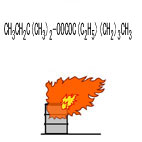| Case Name |
Spontaneous ignition of organic peroxide under storage |
| Pictograph |

|
| Date |
July 28, 2000 |
| Place |
Fukuoka Prefecture, Japan |
| Location |
Household utensils factory |
| Overview |
A fire occurred during storage of organic peroxide. Dry ice prepared for low-temperature security was exhausted, temperature rose, and self-heating decomposition occurred. Although at about 21:00, on July 28th, outdoor temperature was 28 °C, the temperature seemed to be higher in the warehouse. Although the total number of accidents of organic peroxide tends to decrease, accidents on the users' side are almost the same as in the past. |
| Incident |
At a factory producing parts of system kitchens, organic peroxide was cooled and stored in a warehouse. The container exploded, and there was a fire. |
| Processing |
Storage |
| Substance |
t-amylperoxy-2-ethylhexanoate, Fig2 |
| Type of Accident |
Fire |
| Sequence |
100 kg of organic peroxide used as a hardener was stored without opening the seal and cooled with dry ice in a warehouse. The dry ice was exhausted with use, the temperature of the hardener rose, and the temperature exceeded the self decomposition start temperature (35 °C). An exothermic decomposition started, and the plastic container exploded and ignited. An explosion occurred at about 21:00, on July 28th. |
| Cause |
The re-supply of dry ice was delayed, and there was no cooling agent. Therefore, temperature rose and organic peroxide self-ignited. Temperature was high on July 28th, and at about 21:00 the outdoor temperature was still 28 °C. The temperature in the warehouse was higher than the outdoor temperature, and there might have been a danger that it exceeded the self decomposition temperature of 35 °C. |
| Response |
The fire was extinguished by public fire fighters, and there were no employees at the time. |
| Countermeasures |
Manufacturers recognize the dangers of organic peroxide if the temperature rises. However, the user did not consider the dangerous nature of peroxide well. The effect of ambient temperature is very big. In the future, it is important to educate users on temperature control, and it is necessary to keep its temperature low, such as by storing it in a large refrigerator. |
| Knowledge Comment |
The hazard level of organic peroxide with a temperature rise is high, and the effect of ambient temperature is also big. In the future, it is important to educate users on temperature control as they do not have as much knowledge as manufacturers. In the summer, because there are many holidays and the temperature is high, insufficient temperature monitoring over a short period can cause a runaway reaction. |
| Background |
It had been recognized that the danger was high as a hardener was organic peroxide, but dry ice was exhausted sooner than expected because it was in summer. Organic peroxide rapidly decomposes if the temperature rises. If they had known the hazards of the peroxide correctly, it would be unbelievable that they had not prepared more dry ice. They seemed not to understand dangers of organic peroxide correctly. |
| Incidental Discussion |
At manufacturing plants, the number of fires of organic peroxide has decreased. However, the number of fires during consumption and transportation has not decreased. Recognition of safety at downstream stages is insufficient. Fires occur frequently in summer because self-heating decomposition occurs readily as temperature rises. |
| Reason for Adding to DB |
Example of fire caused due to a control mistake of temperature of organic peroxide during storage |
| Scenario |
| Primary Scenario
|
Poor Value Perception, Poor Safety Awareness, Inadequate Risk Recognition, Carelessness, Insufficient Precaution, Inadequate Handling, Usage, Transport/Storage, Inadequate Handling, Malicious Act, Rule Violation, Safety Rule Violation, Bad Event, Chemical Phenomenon, Abnormal Reaction, Secondary Damage, External Damage, Explosion
|
|
| Sources |
Fire and Disaster Management Agency, Fire of organic peroxide under storage. Accident cases of dangerous materials. pp.132-133 (2000)
|
| Physical Damage |
Four slate roofs were damaged. A first-class fire door was deformed. |
| Financial Cost |
¥ 60,000. (Fire and Disaster Management Agency). |
| Multimedia Files |
Fig2.Chemical formula
|
| Field |
Chemicals and Plants
|
| Author |
KOSEKI, Hirosi (National Research Institute of Fire and Disaster)
TAMURA, Masamitsu (Center for Risk Management and Safety Sciences, Yokohama National University)
|